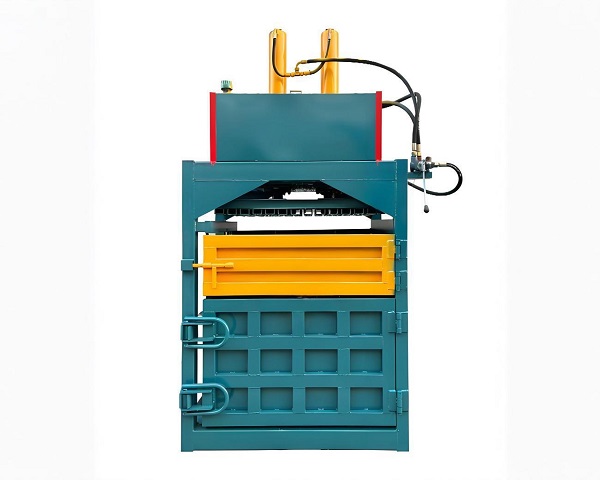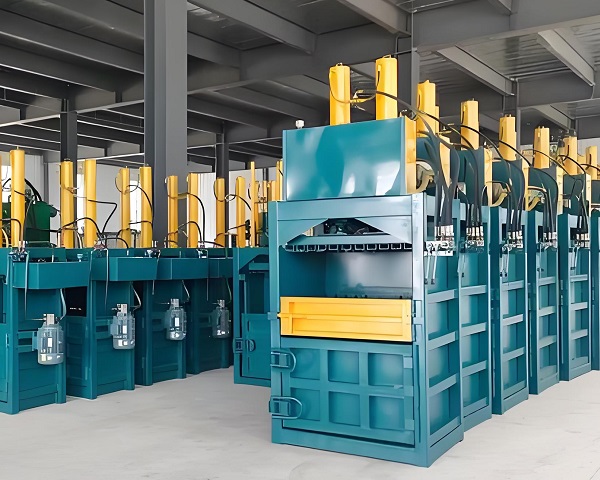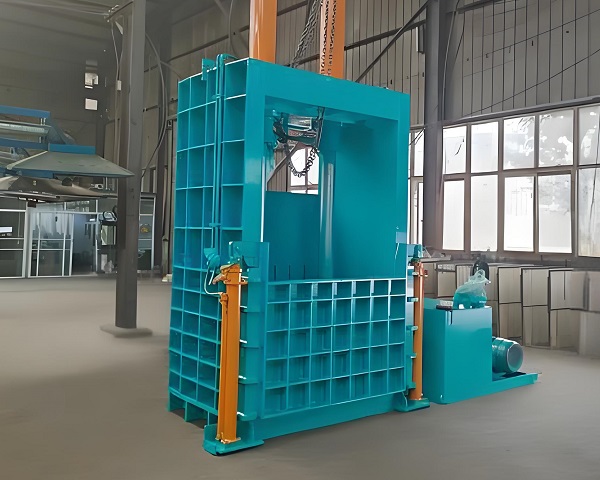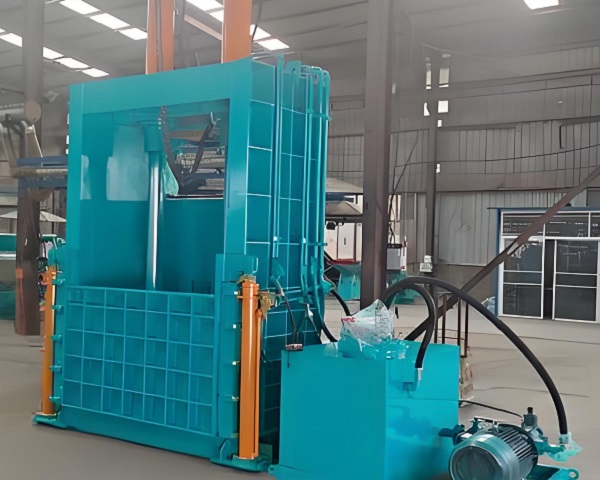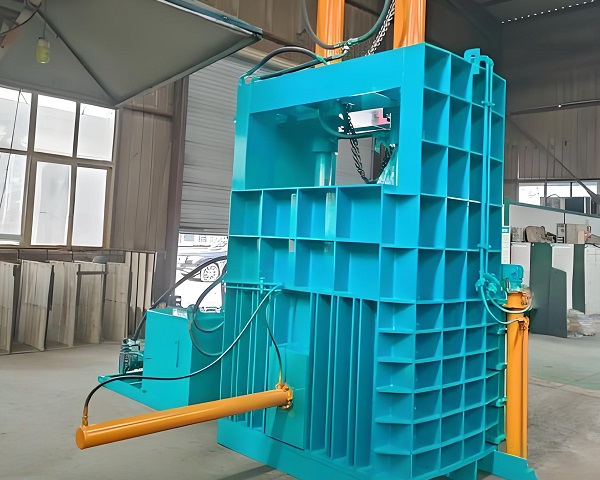A Trommel Screen is a rotary drum screening machine widely used in waste processing, mining, and construction industries. It efficiently separates materials by ......
What is the Vertical Balers
Vertical balers are mechanical equipment with the core functions of compressing materials and improving storage and transportation efficiency. With its unique structural design and performance advantages, it occupies an important position in the fields of industrial production and resource recycling.
From the appearance and structure, the vertical baler is presented in a vertical form. Compared with the horizontal baler, it occupies a small area and is suitable for places with limited space. It is mainly composed of a frame, a hydraulic cylinder, a compression chamber, a control panel and other parts. The frame is used as an overall supporting structure and is made of high-strength steel to ensure the stability of the equipment during operation; the hydraulic cylinder is the power source of the baler and provides strong pressure through the hydraulic system; the compression chamber is used to place the material to be compressed; the control panel facilitates the operator to set parameters and control the equipment.
Its working principle is based on hydraulic transmission technology. After starting the equipment, the hydraulic pump delivers hydraulic oil to the hydraulic cylinder, pushing the piston to generate strong pressure to squeeze the material to be packaged. During the compression process, the material is gradually compressed into a regular block with high density and small volume, and then fixed by a strapping device for subsequent handling and storage. This compression method not only saves space, but also reduces transportation costs.
The advantages of vertical balers are significant. First, it has strong applicability and can handle a variety of materials such as waste paper, plastics, textiles, straw, etc.; second, it has a high degree of automation, and some models support automatic feeding, compression, and bundling processes to reduce manual intervention; third, it has low energy consumption. Compared with similar equipment, it can effectively reduce energy consumption when achieving the same compression effect.
In terms of application areas, it is widely used in waste recycling stations to compress scattered waste paper and plastic bottles into packages to improve recycling efficiency; textile companies use it to pack cloth and cotton wool to save storage space; in agricultural production, the packaging of straw and forage is also inseparable from vertical balers. In addition, in the packaging industry, it can also compress waste packaging materials to help companies achieve environmental protection goals.
With the continuous development of technology, vertical balers are moving towards intelligence and energy saving. In the future, they will play a greater role in more fields and provide strong support for companies to reduce costs and increase efficiency and recycle resources.
Operating principle of Vertical Balers
The working principle of the vertical baler revolves around the two core links of material compression and bundling, and achieves efficient packaging with the help of the coordinated operation of mechanical, hydraulic and electrical systems.
From the perspective of mechanical structure, the main frame of the vertical baler is made of solid steel, which provides stable support for the overall operation. There is a compression push plate that can move up and down inside, and rectangular or square material boxes are surrounded by materials. Its power system is mainly based on hydraulic devices, and components such as hydraulic pumps, hydraulic cylinders, and hydraulic valves cooperate with each other to form a complete hydraulic circuit. When the baler is started, the motor drives the hydraulic pump to operate, extracts the hydraulic oil in the tank, and transports it to the hydraulic cylinder through the pipeline to provide strong power for the compression push plate.
When starting work, the operator puts the material to be packaged into the material box, and then sets the compression parameters such as compression pressure and number of compressions through the control panel. Then, the hydraulic system starts to operate, and the piston in the hydraulic cylinder pushes the compression push plate downward to squeeze the material with strong pressure. During the compression process, as the material is gradually compacted, its internal gaps continue to decrease, and its volume is greatly reduced. The hydraulic valve precisely controls the flow direction and pressure of the hydraulic oil to ensure that the compression push plate can operate smoothly and accurately and achieve the set compression force.
When the material is compressed to the ideal state, it enters the bundling stage. At this time, the bundling mechanism of the baler is started, and PP strapping tape or PET strapping tape is generally used. The strapping tape is automatically wrapped around the compressed material bag through the guide wheel, belt feeding mechanism and other components, and then the two ends of the strapping tape are connected together by hot melting or iron buckle fastening to form a firm bundling. After bundling is completed, the compression push plate rises and resets, and the operator opens the side door of the baler to take out the packaged material bag.
The vertical baler is also equipped with an electrical control system, which uses PLC (programmable logic controller) or single-chip microcomputer to intelligently control the entire workflow, which can not only realize automated operation, but also monitor the operating status of the equipment in real time, and promptly alarm and shut down when abnormalities occur to ensure the safety of equipment and operators. With this working principle, the vertical baler efficiently completes the compression and packaging of materials, greatly improving the storage and transportation efficiency of materials.
Advantages and features of Vertical Balers
With its unique design and functional characteristics, vertical balers have shown significant advantages in many industries. The following is a detailed description of its characteristics and advantages from multiple dimensions.
1. Save space and adapt to a variety of scenarios
Vertical balers adopt a vertical structure design, which greatly reduces the footprint compared to horizontal balers, and is particularly suitable for small and medium-sized enterprises or warehouses with limited space. In places such as urban waste recycling stations and small textile workshops, its compact size can be flexibly placed without taking up too much space, and can make full use of vertical space for material compression, thereby improving site efficiency.
2. Convenient operation and reduced labor costs
The operating interface of this type of baler is simple and clear, and even ordinary workers who have not received complex training can master the operation method in a short time. Most vertical balers are equipped with an automatic control system. By simply setting the compression parameters, the material compression, bundling and other processes can be automatically completed, reducing manual intervention, reducing labor costs, and also avoiding safety accidents caused by improper manual operation.
3. Efficient compression and improved processing capacity
Vertical balers are usually equipped with a high-power hydraulic system that can generate strong pressure to efficiently compress fluffy materials. Taking waste paper baling as an example, the density of the compressed waste paper bales is greatly improved, and the volume can be reduced to 1/5 - 1/10 of the original, which greatly increases the unit transportation volume and reduces the logistics cost. Moreover, its compression speed is fast, which can realize continuous operation and significantly improve the material handling efficiency.
4. Wide application and strong compatibility
It can handle various types of materials, including waste paper, plastic film, textiles, straw, foam, etc. By replacing different molds and accessories, the size and shape of the bales can also be adjusted to meet the diverse needs of different users. Whether it is soft cotton or slightly tough plastic bottles, the vertical baler can effectively compress and show strong material compatibility.
5. Energy saving and environmental protection, in line with sustainable development
The modern vertical baler focuses on energy saving and environmental protection in design. Its hydraulic system uses advanced sealing technology and energy-saving motors to reduce hydraulic oil leakage and energy consumption. At the same time, by efficiently compressing materials, carbon emissions during transportation are reduced, which is in line with the current development trend of green environmental protection and helps enterprises achieve sustainable development goals.
Sturdy and durable, low maintenance cost
The main structure of the vertical baler is made of high-strength steel, which has good rigidity and stability and can withstand long-term, high-intensity workloads. Its key components such as hydraulic cylinders and hydraulic pumps are made of high-quality brand products with reliable quality and long service life. Moreover, the daily maintenance of the equipment is simple and the parts are easy to replace, which greatly reduces the maintenance cost and ensures the continuous and stable operation of the equipment.
Technical Parameter Table of Vertical Balers
| Model | Compression Force (T) | Bale Size (mm) | Motor Power (kW) | Machine Dimensions (mm) | Weight (kg) | Applicable Materials |
|---|---|---|---|---|---|---|
| VB-10 | 10 | 800 × 600 × 800 | 2.2 | 1200 × 800 × 2400 | 800 | Cardboard, Plastic Film |
| VB-20 | 20 | 1000 × 800 × 1000 | 4.0 | 1600 × 1000 × 2800 | 1200 | Cardboard, Plastic Bottles, Fabrics |
| VB-30 | 30 | 1100 × 900 × 1200 | 5.5 | 1800 × 1200 × 3000 | 1600 | Plastic, Waste Paper, Textiles |
| VB-50HD | 50 (Heavy Duty) | 1200 × 1000 × 1200 | 7.5 | 2000 × 1300 × 3200 | 2200 | High-Density Compression, Hard Materials |
| VB-80XL (Optional) | 80 (High Pressure) | 1500 × 1100 × 1400 | 11.0 | 2300 × 1500 × 3600 | 3000 | PET Bottles, Hard Plastic, Thin Metal |
If you have any special requirements, we will customize according to your special needs.
Product Picture Display of Vertical Balers
FAQ about Vertical Balers
>What are the advantages of vertical balers over horizontal balers?
Vertical balers take up little space and are suitable for small sites; they are easy to operate and have low energy consumption, but the single processing volume is relatively small, which is suitable for scenes with dispersed materials and medium output.
>How to choose a suitable vertical baler model?
Factors such as material type, daily processing volume, packaging size, and budget need to be considered. For processing volume, choose high-pressure and large-capacity models; for limited space, choose compact models; special materials need to match corresponding accessories.
>Does the installation of vertical balers require professionals?
It is recommended that professional technicians install them to ensure that the hydraulic pipelines and circuits are connected correctly, debug the equipment pressure and operating parameters, and ensure the safe and stable operation of the equipment.
>What are the key points of daily maintenance of vertical balers?
Regularly check the hydraulic oil level and cleanliness, replace aging seals; lubricate key transmission components; clean the residual materials in the fuselage; check the tightness and wear of the strapping device.
>What should I do if the vertical baler has insufficient pressure?
It may be insufficient hydraulic oil, oil pump failure, pipeline leakage or improper overflow valve setting. It is necessary to check one by one, replenish hydraulic oil, repair and replace parts or readjust pressure parameters.
> What are the safety precautions when operating a vertical baler?
It is strictly forbidden to put your hands or foreign objects into the compression chamber when the equipment is running; check the effectiveness of the emergency stop button regularly; operators need to wear protective equipment; turn off the power before repairing the equipment when it fails.
> What factors affect the packaging efficiency of a vertical baler?
Material fluffiness, hydraulic system pressure, operator proficiency, and equipment maintenance status will affect the packaging efficiency. Maintaining uniform material delivery and good equipment performance can improve efficiency.
> Can the packaging size of a vertical baler be customized?
Most vertical balers support customization, and the compression chamber size and bundling specifications can be adjusted according to needs to meet different transportation and storage requirements.
> How long is the service life of a vertical baler?
Under normal use and maintenance, the service life of a vertical baler is about 8-10 years. The quality and maintenance of key components such as hydraulic cylinders and motors are the key to determining the life span.
>How to solve the problem of high noise when the vertical baler is running?
It may be due to loose parts, insufficient lubrication or abnormal hydraulic system. It is necessary to tighten the loose parts, add lubricating oil, and check the bubbles and vibration sources in the hydraulic pipeline.
>What are the main costs of using a vertical baler?
The cost of use includes equipment procurement costs, daily electricity costs, hydraulic oil replacement costs, replacement costs of wearing parts, and manual operation and maintenance costs.
>What is the working principle of a vertical baler?
The vertical baler drives the pressure plate through the hydraulic system to compress the material vertically downward to the set size, and then the strapping device automatically completes the strapping, using mechanical transmission and hydraulic pressure to achieve compact packaging of loose materials.
>What materials are suitable for vertical balers?
It can handle fluffy and lightweight materials such as waste paper, plastic film, textiles, straw, foam, sponge, etc., and can also adapt to materials of different hardness and shapes by replacing the mold.


























